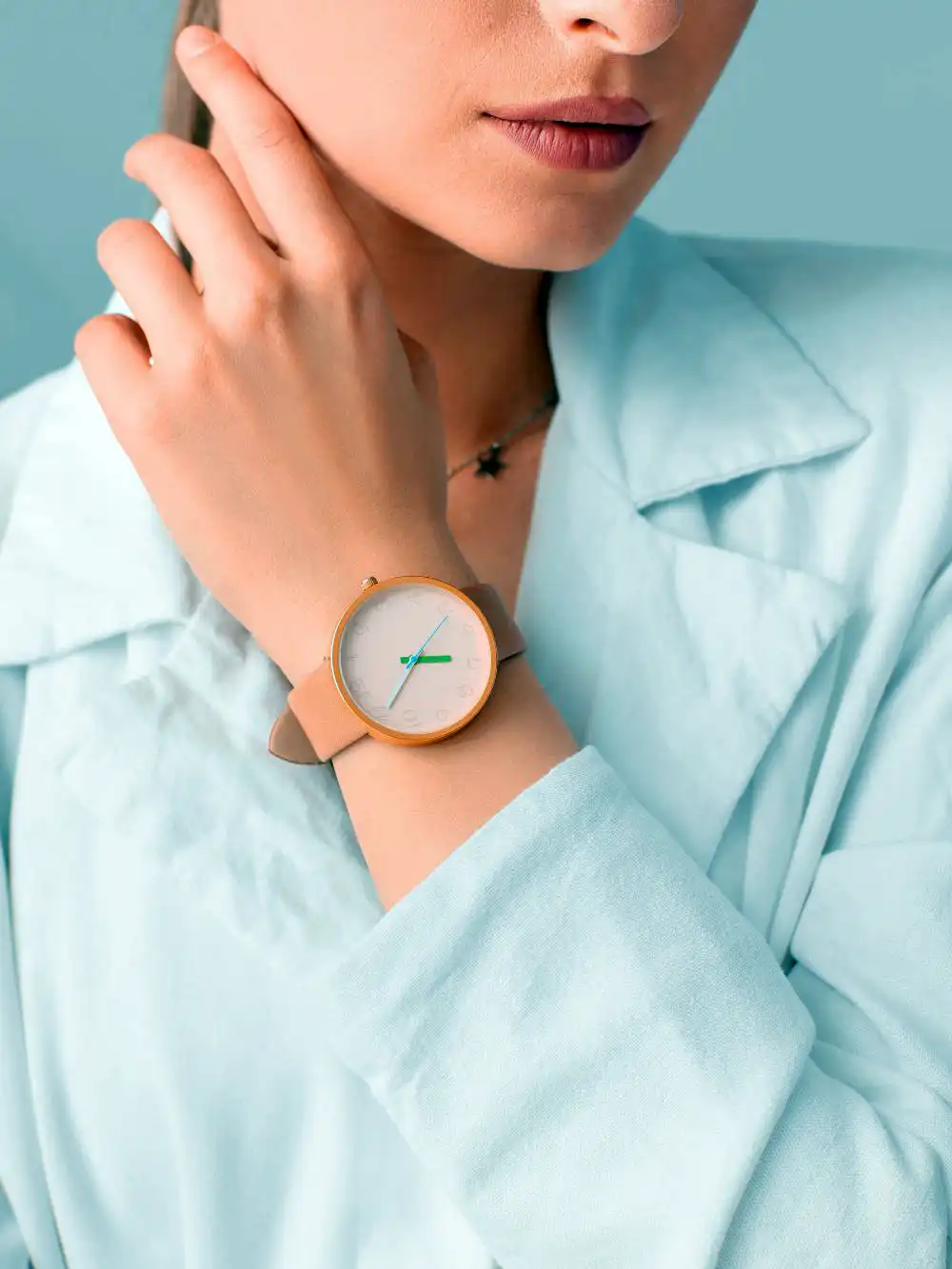Because of old rules, women wore watches on their left hand for a long time. Wristwatches became popular in the 1900s. The reason for wearing them on the left hand was simple. Most people are right-handed. Wearing a watch on the left non-dominant hand frees the right hand to do jobs without the risk of moving the watch.
At that time, it was thought better for women to wear watches on the left hand. This followed the old idea that women should follow tradition. But in the 1900s, more women got educated and had careers. Women-focused more on comfort and doing jobs instead of following strict rules. Because of this, wearing watches on the right hand for women became more accepted.
In the end, a woman should choose the hand that makes her feel good. Things like which hand is stronger and what goes with her clothes should come before old social rules.
For women who like old ways, the left hand has benefits. Watches are designed for the left hand. The right dominant hand stays free for jobs. It also allows wearing bracelets on the right hand with the watch.
But some women prefer the right hand for comfort. Wearing the watch on the right hand can make it easier for women who are right-handed to check the time. Women who exercise often find trackers work better on their strong hands.
In short, old rules said the left hand, but modern thinking likes whatever hand makes a woman feel good. Besides looks, either hand has benefits depending on which hand is stronger and the woman’s daily life and clothes. The most important thing is the woman feels stylish and comfortable no matter which hand she picks.
How do you decide which wrist to wear a watch on?

Dominant hand
If you are wondering which wrist to wear your watch on, consider your dominant hand and the activities you engage in. If you frequently move or bend your wrist, such as during sports or manual labour, wearing the watch on your non-dominant hand might be more comfortable.
This can help avoid interference and discomfort while you work or play.
If you often use a hammer or tennis racket and are right-handed, wearing the watch on your left wrist might be more comfortable. Conversely, wearing the watch on your right wrist might be more comfortable if you are left-handed and use a computer mouse or write with your left hand.
Watch type and style
When deciding which wrist to wear a watch on, you should consider the type and style of the watch. The watch’s design, size, and flexibility can influence which wrist feels more comfortable.
Most people wear watches on their non-dominant hands, so formal or elegant watches may be better suited for the left wrist, as it is the traditional wrist for wearing a watch.
On the other hand, larger sports watches may be more comfortable on the right wrist, especially if you engage in activities that require a lot of wrist movement. This can help avoid interference while you move your wrist.
Other accessories
When deciding which wrist to wear a watch on, you should consider any other accessories you regularly wear, such as bracelets or fitness trackers.
If you wear other items on your wrists, you may want to distribute them between both wrists to avoid overcrowding. This can help balance the weight and prevent discomfort from having too many items on one wrist.
Consider the size and style of your other accessories and how they will fit with your watch. If you have a larger bracelet or fitness tracker, wearing it on your non-dominant wrist may be more comfortable while wearing your watch on your dominant wrist.
Personal comfort
When deciding which wrist to wear a watch on, the most important factor is your personal comfort. Choose the wrist that feels the most natural and comfortable to you.
Consider your daily activities, habits, and personal style when deciding. If you frequently use your dominant hand for tasks that require wrist movement, wearing the watch on your non-dominant wrist may be more comfortable.
On the other hand, if you prefer to wear your watch on your dominant wrist for ease of use, that is also a valid choice. Most importantly, you feel comfortable and confident wearing your watch.
Alternative options
When deciding which wrist to wear a watch on, it’s important to remember that there are alternative options for timekeeping. Many people today rely on their mobile phones or other digital devices to tell time, regardless of gender.
If you find wearing a watch uncomfortable or inconvenient or prefer multiple timekeeping options, using your mobile phone or other digital devices may be a good alternative. This can be especially useful if you engage in activities that make wearing a watch uncomfortable, such as sports or manual labour.
However, consider the factors discussed earlier if you still prefer to wear a watch. These factors include your daily activities, personal style, and comfort.
Ultimately, deciding which wrist to wear your watch is a personal preference. Alternative options are available for timekeeping if you choose not to wear a watch.
What is the psychology of wearing a watch in the left hand?
Wearing a watch on the left wrist instead of the right can reveal clues about a person’s psychology. Several factors may influence which wrist a person chooses.

Dominance and authority
Historically, left wristwatches have been associated with the military and positions of authority. Wearing a watch on the left wrist may communicate a take-charge or dominant personality. This stems from associating the left hand with skill and competence.
Spatial ability
The left side of the brain controls the right side of the body. The left brain hemisphere is dominant in logic, language, and mathematical reasoning. Since many people wearing a left wristwatch likely do so due to skill with their left hand, this may indicate higher spatial and logical abilities.
Tradition
Social norms dictate that most people wear watches on their right wrist. Those who buck tradition by wearing a left wristwatch may have a non-conforming or independent personality. They enjoy going against societal rules and conventions.
Fashion
Some people simply prefer the aesthetic of a left wristwatch. While fashion choices do not directly reveal inner qualities, they do indicate personal values and priorities. Left wristwatches have become more common and stylish in recent decades.
Practicality
Most watch crowns are located on the watch’s right side for a right-handed wearer. For left-handed people, a left wristwatch may be more practical to adjust and operate. Some opt to wear a watch on their non-dominant wrist to avoid damaging it while using their dominant hand.
A watch wearer’s left versus right wrist choice reveals clues about their handedness, personality, and priorities. However, individual circumstances are unique. Dominant hands, social influences, and personal style all factor into how and why a person wears a watch on their left wrist. No single reason applies to all left wristwatch wearers.
What is the psychology of wearing a watch in the right hand?
Several factors influence why some people choose to wear their watch on the right wrist instead of the left. Individual circumstances, personality traits and cognitive abilities all shape this preference.
Wearing a watch on the right wrist is typically more practical and comfortable for right-handed individuals. Since watches are designed for right-handed wear, the crown and buttons are easier to manipulate with the right hand. The right wrist also provides an unobstructed view of the watch’s face.
There are also potential psychological implications. Wearing a watch on the dominant hand may indicate excitement-seeking and distractibility. Some research suggests that right wristwatch wearers are more prone to daydreaming and getting distracted.
However, right-wrist wearers may also have enhanced proprioceptive awareness of their surroundings due to frequent watch checking.
Right wristwear has been associated with confidence and power. Historically, wristwatches symbolised wealth and status; wearing one on the dominant hand communicated authority and leadership. Right wristwatches may still convey a sense of self-assuredness and dominance.
For most individuals, mixed factors likely influence their choice. Alongside practical concerns, personal values, social influences and lifestyle priorities all shape preferences.
Some choose Fashion more on comfort and aesthetics, while others select watches that complement their active careers and hands-on work.
In the end, an individual’s specific reasons for wearing a watch on the right wrist likely depend on a complex interplay of traits, circumstances and influences. People wear watches for diverse motivations associated with identity, function and self-expression.
Difference between wearing a watch on right and left hand
Right wristwatch wearers tend to prioritize factors like comfort, aesthetics and image, while left wrist wearers place more value on independence, function and practicality. However, these are generalizations, and many individual exceptions exist. A complex interplay of handedness, personality, influences, and lifestyle shapes overall preference.
Here is a table summarizing some of the key differences between right-wrist and left-wrist watch wearers.
| Right Wrist Watch Wearers | Left Wrist Watch Wearers |
|---|---|
| Tend to be right-handed | Tend to be left-handed |
| Find it more practical and comfortable | Find it more practical and comfortable |
| Easier to operate watch crown and buttons | Easier to operate watch crown and buttons |
| May indicate distractibility and daydreaming | May indicate independence and non-conformity |
| Associated with confidence and authority | Associated with creative and logical thinking |
| More common due to social norms | Less common due to social norms |
| Often chosen for aesthetic reasons | Often chosen for comfort and function |
| May enable better proprioceptive awareness | May correlate with better spatial awareness |
| Often selected to match self-image as active or dominant | Often selected to match self-image as casual or laid back |

Summary
Wristwatches became popular in the 1900s, and women were encouraged to wear them on their left hand to follow tradition, but more educated and career-focused women began to prioritize comfort over old rules.
Factors such as dominant hand, watch type and style, other accessories, personal comfort, and alternative options should be considered when deciding which wrist to wear a watch on.
Wearing a watch on the left wrist may communicate a dominant personality, higher spatial and logical abilities, or a non-conforming or independent personality.
Wearing a watch on the right wrist may indicate practicality, distractibility, confidence, and power. Finally, individual circumstances and preferences shape how and why a person wears a watch on their left or right wrist.
FAQ
Is it OK to wear watch on right hand?
Yes, it is perfectly fine to wear a watch on your right hand. While wearing a watch on the left wrist is more common, no hard and fast rule dictates which wrist a watch should be worn on.
Which hand is best for a lady to wear watch?
The accepted convention is for women to wear a watch on their left wrist, which is considered more traditional and practical. However, deciding which wrist to wear a watch on ultimately depends on personal preference and comfort.
Why do people wear watches on the inside of their wrist?
One of the most common reasons is to protect the watch from getting scratched or damaged. Another reason is that wearing a watch with the face on the inside of the wrist can prevent reflections and glare, which can be particularly important in certain professions or situations, such as military personnel or special forces.
What side do nurses wear their watches?
Nurses often wear their watches on the inside of their wrists, facing away from them, to prevent them from getting in the way or getting dirty during their work.



